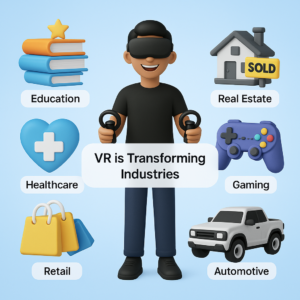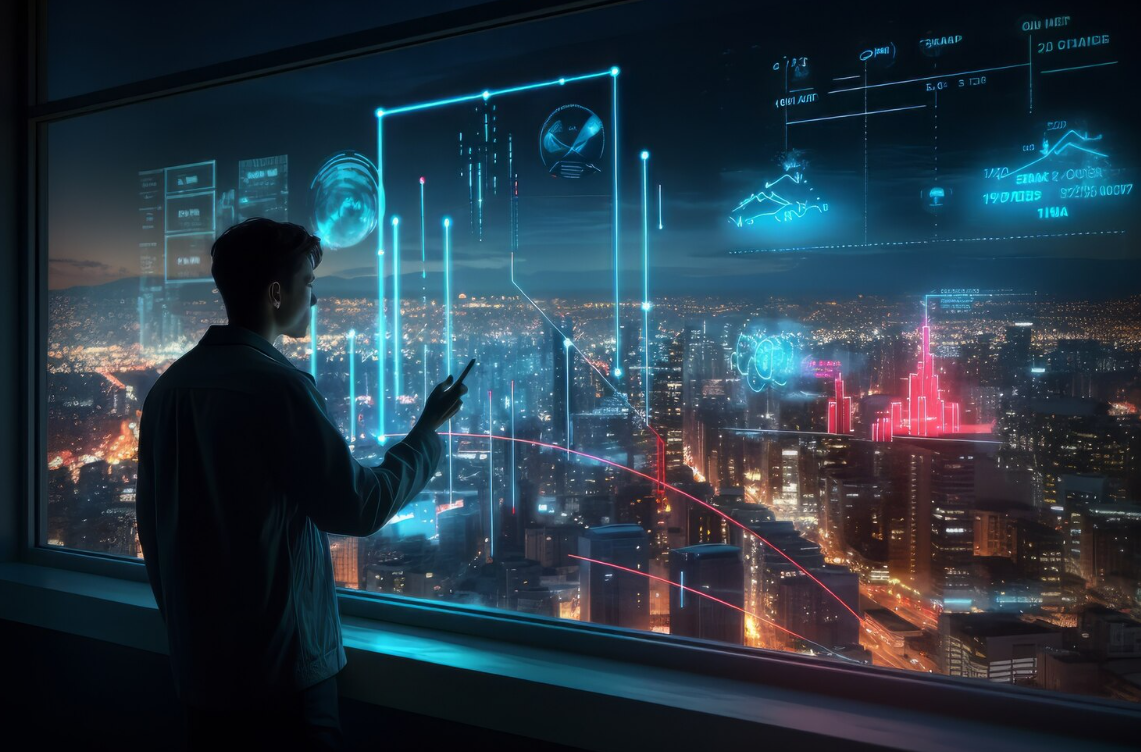With the growing adoption of technology, there is a high need for companies to innovate on Virtual Reality Tech. VR applications are now developed in a wide range of industries and organizations. They include architecture and engineering in education, psychology, and activism.
Until recently, VR was only associated with the gaming and entertainment industries. It is now used in a variety of industries. This can change the way we interact with one another. It will change our perspective of businesses and organizations, and also with our surroundings.
Companies Leading In Virtual Reality
Dassault Systèmes
Dassault Systemes is one of the world's largest VR companies. They offer project lifecycle management solutions. It allows companies to create and share 3D experiences. Dassault Systèmes has also created a user-friendly virtual reality experience. Based on Immersive Virtuality, it also helps students to enjoy the learning process.
Advanced Micro Devices (AMD)
AMD is one of the world's largest semiconductor companies. AMD has groundbreaking LiquidVR technology. It also allows rich and immersive virtual reality experiences. This also facilitates the creation of virtual reality content. It enables many unique AMD hardware features. These features are designed to work in tandem with Radeon graphics card headsets. Also, AMD systems produce realistic real-time images with high-resolution stereo and fast refresh rates.
HTC Corporation
HTC Corporation is a Taiwanese company. They develop, manufacture, assemble, process, and sell smartphones and virtual reality devices. Also, HTC's Vive is one of the most popular VR headsets on the market. The company's headsets provide users with fantastic experiences. These range from games like ping-pong or pool to cross-category experiences. It also has features like SteamVR tracking, HD graphics, and a 110 field of view, etc.
NVIDIA
NVIDIA is one of the most innovative designers and manufacturers. They produce computer GPUs, chipsets, and other multimedia software. It is the world's leading visual computing company. NVIDIA is also at the forefront of this groundbreaking new VR platform. NVIDIA also provides the best VR solutions. Their solutions include industry-leading Turing GPUs, drivers, and SDKs. These products aim to meet the needs of professionals, gamers, and developers. They serve from gaming to product design to film experience and beyond.
Qualcomm
QUALCOMM, Inc. is a digital telecommunications company. It manufactures, designs, and delivers products and services. Furthermore, Qualcomm has a goal to create improved VR experiences. Their products aim at fully immersive mobile VR. Their chips also provide a cost-effective computing solution optimized for VR applications.
Tencent Holdings
Tencent Holdings Ltd. is a leading provider of value-added services. It includes online and mobile games, community value-added services. It also includes applications across many Internet and mobile platforms, and online advertising. Moreover, the China-based tech behemoth is one of the world's largest gaming companies. Also, they have hit titles like League of Legends, Honor of Kings, and Game for Peace to their credit. The company developed games for VR platforms and include headset support in some titles.
Facebook Inc
Facebook has established a strong position in the online advertising market. It has also changed the way the world connects by leveraging its technological strengths and massive reach for its software. Facebook paid $2 billion for the virtual reality company Oculus in 2014. Horizon is a social VR experience where users can explore, play, and create with others. It was beta-launched by Facebook in 2020. Facebook is now one of the largest VR companies in the world.
Intel
VR and AR are impossible to imagine without capable semiconductors. Also, Intel has long been the market leader in this area. A high-end VR experience necessitates powerful hardware. Intel has addressed this with some of its new VR processors. It has also developed high-end 360-degree cameras and software. They also help in broadcasting professional sports content for VR devices used by NBA, MLB, and NFL teams.
Oculus
Oculus is the first company to create a modern VR headset. The company, purchased by Facebook for $2 billion in 2016 continues to operate as a separate VR company on the platform.
Samsung
Their first branded smartphone-based VR experience was the Samsung Gear VR. It was likely the first low-cost option for mid-range VR experiences. It is also a more preferable option to avoid the expensive options. Moreover, Samsung has an extensive VR content library/store. Samsung has promoted VR use with a dedicated VR browser for Samsung devices.
Alphabet
Google's parent company, Alphabet, involves itself in almost every aspect of the industry. It includes search engines, artificial intelligence, VR, AR, networking, computers, the IoT, drones, space projects, smartphones, etc. It is one of the largest VR companies in the world.
Ways For Companies To Innovate On Virtual Reality
Dining
Gastronomical VR experiences have been created by Project Nourished. It has the goal of giving customers the experience of eating foods without actually eating them.
Customers would sit at their table and see a sushi roll through their VR headset. When they pick the food, the aromatic diffusers turn on. They release the scent of sushi. When it's put in the customer's mouth, they get a taste of sushi. But, the sushi is made with agar-agar. Agar-agar is a low-calorie, vegan alternative gelatine derived from seaweed.
Moreover, this technology has the potential to help with a variety of issues. This also includes more sustainable feeding, weight loss, and overeating control. It can do all this through substitution and simulation.
Healthcare
VRHealth has teamed up with Oculus Go. They aim to bring virtual reality technology to the healthcare industry. It would also help address issues such as mental health, pain management, and rehabilitation.
VR headsets for healthcare are currently used in hospitals across the United States. They treat cancer patients during chemotherapy. It also helps laboring mothers manage their pain. People with access to VR are also more likely to stay in a rehabilitation program, according to research.
Astronautics
NASA has built a VR Laboratory that astronauts use to prepare for their missions. The facility has real-time graphics and motion simulators. It also has robotic devices that give the sensation of mass and inertia when handling large objects. The main goal is to help crew members become self-sufficient. This would also help them when working in deep space, where help may be scarce.
Risk-Free Adventure Sports
In this, the riders are suspended in a harness. They experience up and down motion, as well as abrupt drops and smooth descents. This is to simulate paragliding.
Recruitment
Traditional recruitment processes are being reshaped by VR-based assessments. Companies like Lloyds Banking Group have incorporated VR into their assessment centers.
Candidates wear VR goggles and take part in immersive computer-generated scenarios. This is something that could never happen in a traditional interview setting. It gives employers insight into how candidates would perform in real-world scenarios. It also allows candidates a look at their future working conditions and activities.
Challenges Faced By Companies To Innovate On Virtual Reality
Hardware Issues
Currently, every AR headset on the market is a large piece of equipment. It is also expensive for the average person. Moreover, the majority of VR headsets need a connection to a computer. This limits and inconveniences the experience. Consumers can also use VR applications on their smartphones or tablets. But, displaying visuals accurately on mobile is a major challenge. Electric interference can also disrupt mobile sensors. Also, smartphone cameras capture 2D images and cannot render 3D images. Before VR adoption, the hardware required for it needs improvement.
Limited Content
Creating engaging content is the most difficult aspect of AR and VR. Games and filters from social media platforms are among the content created for AR devices. Creating content that promotes businesses can also be difficult and costly. Also, AR developers have not yet developed enough high-functioning use cases for consumers to use on a daily basis.
Regulations Are Lacking
There are no regulations to inform businesses and consumers about the types of AR applications that can be used and how data can be processed. This also results in the malicious use of the technology. In such cases, consumers may wonder who is responsible, what mitigation strategies to use, and how to avoid similar incidents in the future. Therefore, creating regulations that ensure the privacy and security of consumer data, meanwhile also simplifying mainstream adoption of the technology, is one of the major challenges of AR/VR.
Skepticism Among The General Public
AR and VR are a hot topic among tech experts, still, most consumers are unaware of its advantages. Consumers have only experimented with the most popular AR/VR applications. Consumers also need education on the various uses and benefits of AR/VR. Also, a lack of awareness may lead to privacy and security concerns. As a result, users' concerns must be addressed to hasten the mainstream adoption of AR/VR.
Risks of Physical Safety
VR apps can be distracting and even cause physical harm. Many people get injured while playing VR games and using AR apps. AR/VR technology is still in its infancy. Some R&D into the applications would be needed to overcome the technology's problems. It will lead to large-scale adoption.
Conclusion
There are skepticism and financial constraints to VR tech. They have prevented companies from investing in AR/VR. But, there is a need for companies to innovate on virtual reality. The technology's r++ole in safe workplace training, delivering expert knowledge, and its potential to improve the customer experience will force companies to reconsider the technology's adoption.+++++++++++
As VR technology advances and becomes more adopted, many opportunities will open up. These advancements will also be important to VR's success. It's critical to start incorporating it into our virtual environment today so that its full potential can be realized in the future.
You may like to read:
VR And AR In Food Business: Their Impact and Benefits
How Can VR Be Used In Therapy To Treat Mental Health






